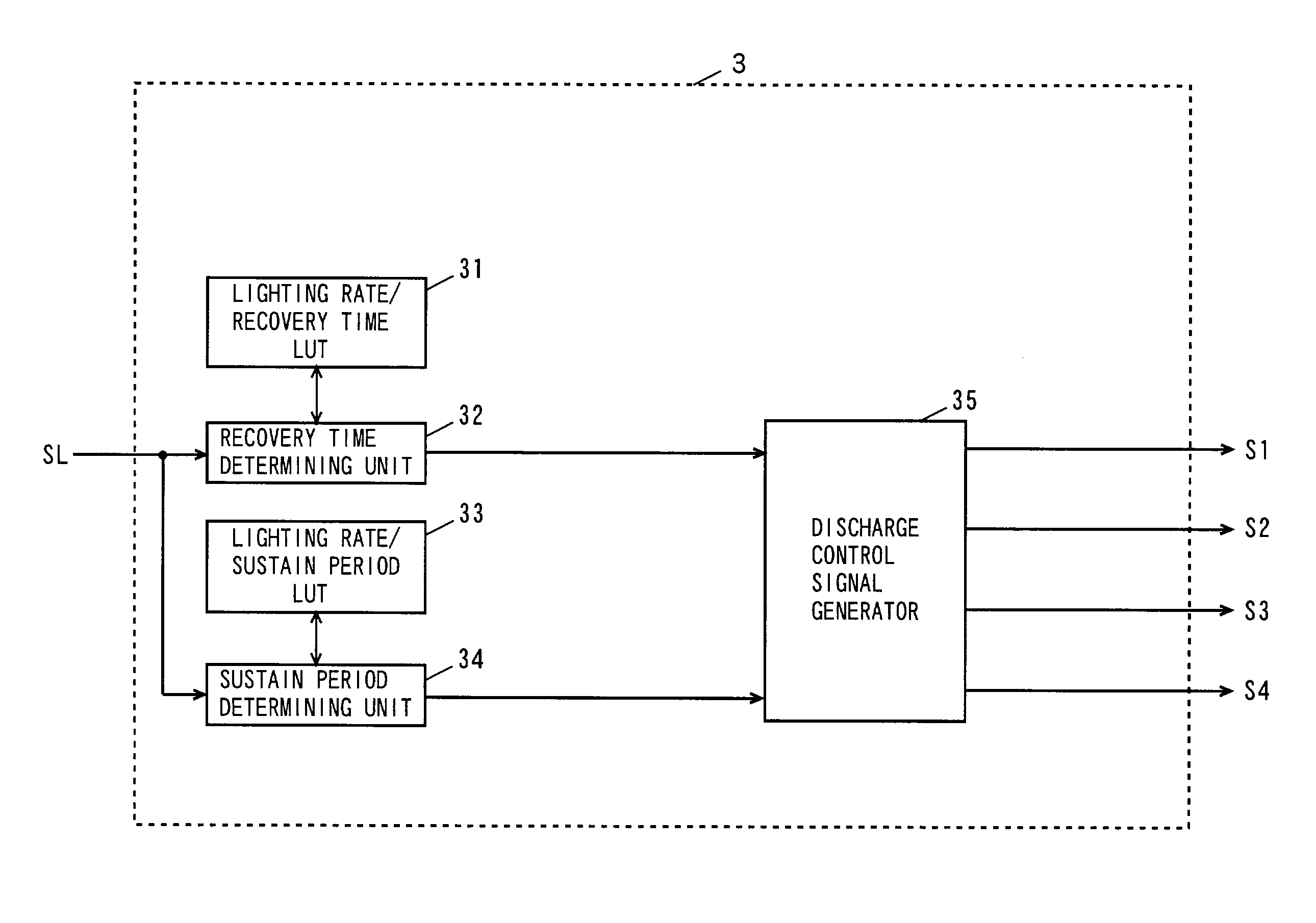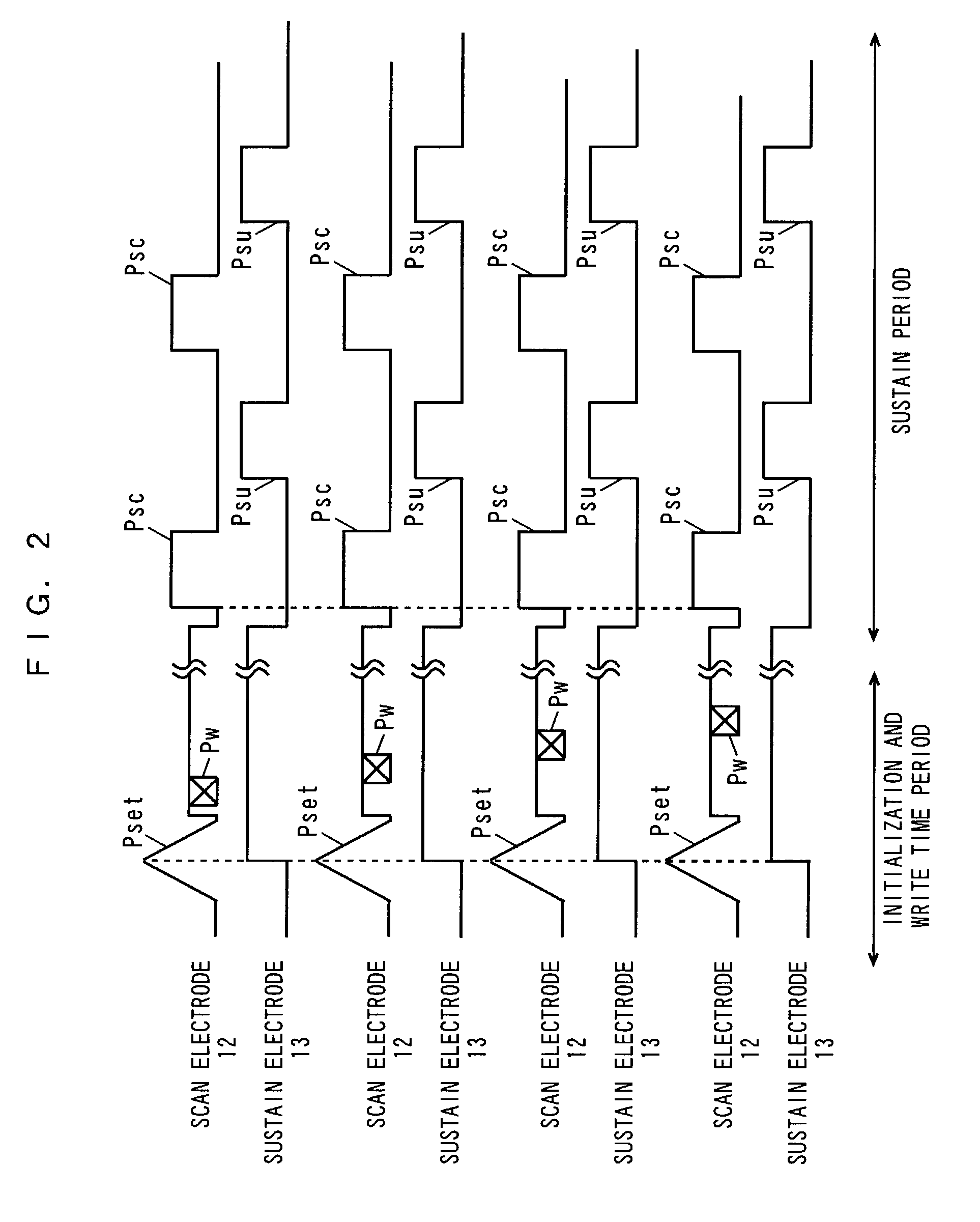Display and its driving method
- Summary
- Abstract
- Description
- Claims
- Application Information
AI Technical Summary
Benefits of technology
Problems solved by technology
Method used
Image
Examples
first embodiment
[0113]Description will now be made on an AC type plasma display device as one example of a display device in accordance with the present invention. FIG. 1 is a block diagram showing the structure of a plasma display device according to the present invention.
[0114]The plasma display of FIG. 1 includes an A / D converter (analog-to-digital converter) 1, a video signal / subfield corresponder 2, a subfield processor 3, a data driver 4, a scan driver 5, a sustain driver 6, a PDP (plasma display panel) 7 and a subfield lighting rate measuring unit 8.
[0115]The A / D converter 1 is supplied with a video signal VD. The A / D converter 1 converts an analog video signal VD into digital image data to output the image data to the video signal / subfield corresponder 2. In order to display by dividing one field into a plurality of subfields, the video signal / subfield corresponder 2 produces image data SP for each subfield from image data in one field to output the produced image data SP to the subfield pr...
third embodiment
[0260]In this embodiment, the transistors Q3, Q4, Q7 and Q8, the recovery capacitor Cr, the recovery coils L1 and L2, and the diodes D1 and D2 correspond to recovery means; the subfield processor 3b to control means; the transistors Q7 and Q8, and the recovery coils L2 and L2 to inductance means and variable inductance means; and the transistors Q7 and Q8 to second switch means. The remaining parts are the same as those in the
[0261]FIGS. 32 to 35 are timing charts showing operations of the sustain driver 6c of FIG. 31 in the sustain time period. The voltage on the node N1 and the control signals S1 to S5 shown in FIG. 31 are illustrated in FIGS. 32 to 35.
[0262]As shown in FIGS. 32 to 35, in the sustain driver 6c like the third embodiment, a time period TA to be the discharge recovery time, and delay times DT1 and DT2 are controlled depending on the lighting rate, while a time period TC to be the non-discharge recovery time, and delay times DT1 and DT2 are also controlled depending o...
fourth embodiment
[0278]As-shown in FIGS. 39 to 42, in the sustain driver 6d, a time period TA to be the discharge recovery time and delay times DT1 and DT2 are controlled depending on the lighting rate, while a time period TC to be the non-discharge recovery time and delay times DT1 and DT2 are controlled depending on the lighting rate, like the
[0279]As described above, in this embodiment, the lighting rate for each subfield is detected. As the detected lighting rate for each subfield becomes lower, the discharge recovery time, the non-discharge recovery time, the resonance time and the sustain period at the rising and falling of sustain pulses can become longer, resulting in achievement of the same effect as in the first embodiment.
[0280]Furthermore, since the on / off states of the transistors Q9 and Q10 can independently be controlled by the control signals S5 and S6, it is possible to independently control the resonance time at the rising of sustain pulses and that at the falling of the sustain pu...
PUM
 Login to View More
Login to View More Abstract
Description
Claims
Application Information
 Login to View More
Login to View More - R&D
- Intellectual Property
- Life Sciences
- Materials
- Tech Scout
- Unparalleled Data Quality
- Higher Quality Content
- 60% Fewer Hallucinations
Browse by: Latest US Patents, China's latest patents, Technical Efficacy Thesaurus, Application Domain, Technology Topic, Popular Technical Reports.
© 2025 PatSnap. All rights reserved.Legal|Privacy policy|Modern Slavery Act Transparency Statement|Sitemap|About US| Contact US: help@patsnap.com



